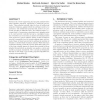Free Online Productivity Tools
i2Speak
i2Symbol
i2OCR
iTex2Img
iWeb2Print
iWeb2Shot
i2Type
iPdf2Split
iPdf2Merge
i2Bopomofo
i2Arabic
i2Style
i2Image
i2PDF
iLatex2Rtf
Sci2ools
DRM
2005
Springer
2005
Springer
Hybrid static-dynamic attacks against software protection mechanisms
Advances in reverse engineering and program analyses have made software extremely vulnerable to malicious host attacks. These attacks typically take the form of intellectual property violations, against which the software needs to be protected. The intellectual property that needs to be protected can take on different forms. The software might, e.g., consist itself of proprietary algorithms and datastructures or it could provide controlled access to copyrighted material. Therefore, in recent years, a number of techniques have been explored to protect software. Many of these techniques provide a reasonable level of security against static-only attacks. Many of them however fail to address the problem of dynamic or hybrid static-dynamic attacks. While this type of attack is already commonly used by black-hats, this is one of the first scientific papers to discuss the potential of these attacks through which an attacker can analyze, control and modify a program extensively. The concep...
| Added | 27 Jun 2010 |
| Updated | 27 Jun 2010 |
| Type | Conference |
| Year | 2005 |
| Where | DRM |
| Authors | Matias Madou, Bertrand Anckaert, Bjorn De Sutter, Koen De Bosschere |
Comments (0)

